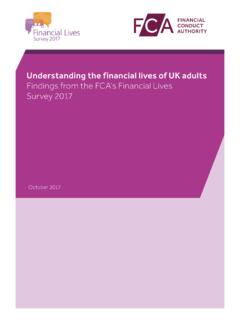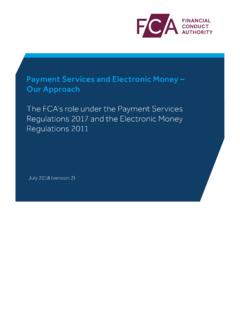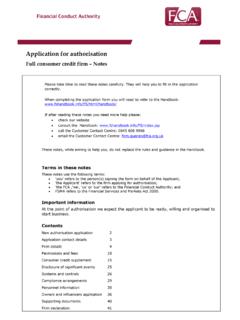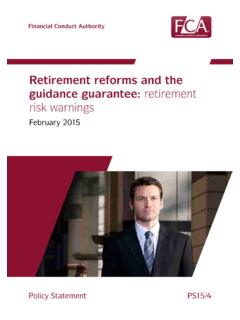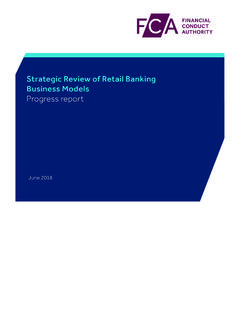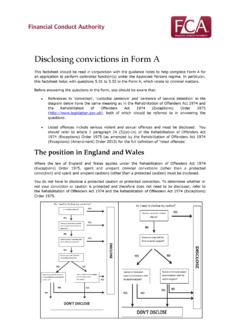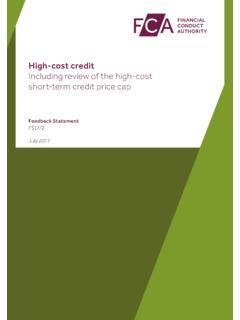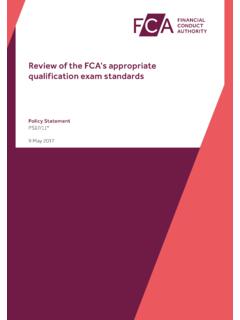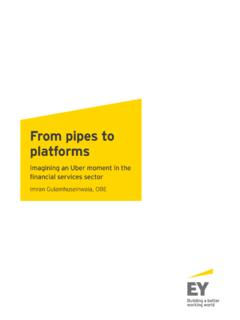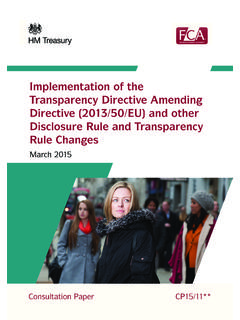Transcription of Climate Financial Risk Forum Guide 2021: Appetite Statements
1 1 Climate Financial RISK Forum Guide 2021 Climate RISK Appetite STATEMENTSO ctober 2021 2 Contents 1 Overview .. 4 2 Insurers .. 6 3 Asset Managers .. 14 4 Retail Banking .. 20 5 Corporate Banking .. 23 3 This chapter represents the output from the Risk Management Working Group of the Climate Financial Risk Forum (CFRF). The document contains information constructing a risk Appetite statement and metrics. This CFRF Guide has been written by industry, for industry. The recommendations in this Guide do not constitute Financial or other professional advice and should not be relied upon as such. The PRA and FCA have convened and facilitated CFRF discussions but do not accept liability for the views expressed in this Guide which do not necessarily represent the view of the regulators and in any case do not constitute regulatory guidance.
2 Copyright 2021 The Climate Financial Risk Forum 4 1 Overview Developing a Climate risk Appetite statement (RAS) is an essential aspect of Climate risk management, to align understanding of the level and type of risk that is accepted in pursuit of a firm s strategy. This document builds on the information in the CFRF 2020 Guide . The aim is to offer practical advice on writing, implementing and maintaining an effective RAS, factoring in different aspects of Climate risk. The CFRF Risk Management Use Case document outlines practical steps in specific use cases for developing and embedding the RAS. This builds on the principles outlined in this RAS document. The content in the document comprises a range of example practices from firms, leading thinking and industry papers.
3 It is not intended to signify a benchmark for best practice. The document is structured by industry grouping, covering: Insurance Asset management Corporate Banking Retail Banking In the document we have focused on a number of specific risks aspects of Climate risk Appetite : the impact of Climate change on the firm through physical and transition risk; the impact of the firm on the Climate through net zero (or other) alignment; and the most widely applicable Financial risk categories, credit risk. Wider sustainability and corporate social responsibilities are not considered here in line with the focus of the PRA s Supervisory Statement SS3/19 on Climate -related Financial risks. The operational and non- Financial risk aspects of the RAS will be considered for development in future sessions of the CFRF given the ongoing development of FCA guidance in this area.
4 The UK Climate Financial Risk Forum : Climate Data & Metrics Report contains additional information on use cases and metrics, that are introduced throughout this document. Integration with existing Risk Appetite Framework Different firms may take different approaches to how Climate risk Appetite is presented internally. For example, a subset of metrics may be included within a RAS (at either enterprise or entity level); or there may be a standalone Climate , ESG or Sustainability RAS. These approaches are not exclusive and may even be combined. Good practice is to align the approach for addressing Climate within the risk Appetite with the approach adopted for existing risk categories or cross-cutting risks. A Climate RAS should ideally consider the following elements: Transition risk Physical risk 5 Alignment (to either net zero, a temperature target or some other strategic/scientific-based Climate -related objective) Ownership and Integration in Governance The approach to establishing ownership for Climate risk and integrating it with the RAS should mirror the approach for other risks.
5 However, given the cross-cutting nature, a mechanism should be in place to ensure there is a holistic view of the Climate risk. Whether this is a designated individual with formally delegated responsibility, or a full team will depend on the complexity and materiality of the risks to the organisation. There is a clear expectation of ownership in the First Line of Defence, and a dependency on the detailed definition of strategy and business objectives. Note: An outline of roles and responsibilities across the three lines of defence can be found in the CFRF 2020 Risk Management Chapter. Longer term enhancements More advanced firms will develop, over time, a Climate RAS which incorporates insights from scenario analysis (including transition glide paths) and Financial and strategic planning.
6 A mark of success over a 3-5 year timeframe, will be the ability to cascade and embed RAS metrics into business practices, scorecards, and Financial and operating plans which help steer the balance sheet. 6 2 Insurers Ownership and integration into governance Ultimately, an insurer s board of directors should own the highest level of the Climate change risk governance. But the actual risk takers should assume responsibility for the more granular, concrete measures. Climate risks should be embedded in existing governance frameworks as much as possible, and potential approaches for doing this include the following: Developing a defined Climate strategy as part of a wider sustainability or ESG strategy; Incorporating Climate risks into the firmwide RAS, through either qualitative or quantitative articulation of which risks to pursue; Integrating Climate risk limits into the existing Limit Framework (where limits may be owned by either the first or second line); and Integrating within governance policy documents that are owned by the respective functions - for example: risk management, actuarial reserving, investment, and underwriting.
7 While additional oversight may be needed to ensure a comprehensive coverage of Climate risks, incorporating within the firm s existing governance structures rather than by creating new ones is likely to achieve more sustainable embedding. As both the science and risk management of Climate change is evolving, firms should expect to review their approach regularly to ensure it remains up to date. Approaches and metrics The first stage in developing a Climate risk Appetite is to assess the firm s exposure to the risks from Climate change. The next step is to consider the best approach to defining RAS for those exposures. Impacted risk categories The risk categories most impacted by Climate change will largely depend on the business model of the firm and the regions in which it operates.
8 While the impact of Climate risks may be quantified, there remains significant limitations on data and models and uncertainty over the timing of when these risks will become material. For example, for general or Property and casualty (P&C) insurers, the potential physical losses from Climate change are seen today, but may not materialise fully for 20+ years. That said, the potential transition risks within their investment portfolio may be more immediate. For Life and Health (L&H) underwriting, Climate change remains a potential, emerging risk, because of the material uncertainty of the timing and magnitude of the physical impacts. 7 To support the assessment of the different types of Climate risks, the impacts of Climate risks can be bucketed into two categories: Traditional business risks comprise Climate risks that materialise through changes to the risks typically captured in existing categories, resulting in higher losses.
9 New risks and opportunities include transitional risks that are proportionate to the carbon intensity of the underlying activity. These risks may be related to an insurer s own emissions footprint or those associated with their assets or liabilities. This includes strategic risks that change the risk profile of the firm s long-term strategic objectives. Traditional business risks The traditional/established risk categories of P&C insurers that are most likely to be impacted are shown below. The materiality of the impact will depend on the underlying business model of the enterprise and should be assessed individually on a firm-by-firm basis. Underwriting catastrophe risk. Climate change is increasing the uncertainty of catastrophe risk for P&C insurers, due to the potential for the frequency and/or severity of events to deviate from long-term average for perils such as flood (pluvial, coastal and fluvial) or wildfires (see IPCC report).
10 Reflecting long-term gradual change represents a challenge for P&C insurers, who typically take short-term underwriting risk, over one to two years. Some P&C insurers are already quantifying the likely trend in extreme flood and prolonged or repeated events, and reflecting these in business plans and reinsurance strategy. As the risk of increased catastrophe losses from Climate change grows, insurers will have the ability to re-price the risk (charge increased premiums at renewal) or walk away. At the same time, they are likely to continue to work with public authorities on mitigation ( flood defences) and market solutions ( risk pools). For mortality underwriting, future changes in assumptions may lead to material impacts on current reserving assumptions.
